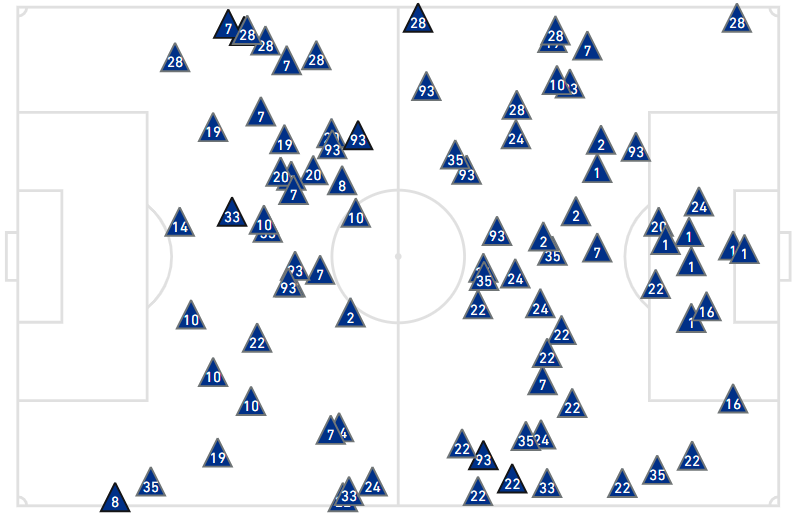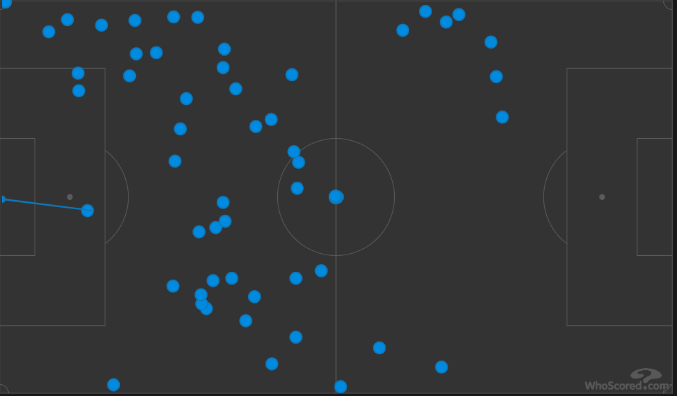The Pat Noonan era certainly didn’t get off to the start FC Cincinnati fans were hoping for in Austin on Saturday. The 5-0 scoreline is reminiscent of too many FCC performances over the last three seasons. However, for as bad as the box score looks, there are some positives we can take.
Think back to the 2021 season opener. FCC scored twice in the first 12 minutes at Nashville and barely held on to earn a point. That night, the Orange and Blue were outshot 32 to 6 and Nashville created 3.4 xG compared to FCC’s 1.8. Nearly all of Cincy’s total came from two shots, including a penalty. Against Austin, the statistics were far closer but the result was much worse. Sure, Austin outshot FCC 19 to 14 and created 2.8 xG to FCC’s 1.3 but even those numbers are a little misleading. For instance, Austin’s first goal, the result of a poorly defended free kick, accounts for 0.51 xG of the total, per MLS Soccer.
I’m not arguing FCC played well. Looking at the underlying numbers, without knowing the final score, the season opener doesn’t look like a match that finished 5-0. Austin certainly created more quality scoring chances over the course of the match but, looking closer, we can see how Noonan wants his team to play. Not only were the attacking and defending ideas evident, the Orange and Blue executed them consistently and effectively throughout the ninety minutes. They just didn’t lead to goals or points on Saturday. That happens sometimes. There are (obviously) plenty of areas to improve going forward but, to my eye, FCC already looks like a more cohesive team just one game into the Noonan era.
Pressing From The Front
Last week, I wrote about watching for how and when FCC pressed its opponents in 2022. Well, now, one game in, Noonan and Chris Albright stuck with their Philadelphia Union roots and brought an aggressive pressing style against Austin. Though FCC pressed slightly more against Austin than its 2021 season average, there was a major difference in where the pressure was applied. FCC did the vast majority of its pressing in the middle and final thirds of the field. Obvious small sample caveats apply but just look at how much more pressure was applied in the attacking third of the field on Saturday than last season.  For stretches throughout the match, FCC pinned Austin back in its defensive third. The Orange and Blue won the ball high up the field, intercepting bad passes, winning tackles, or forcing Austin defenders or goalkeeper Brad Stuver to play directly over the press to areas of the field where FCC defenders were in positions to win the ball. MLS Soccer’s chalkboard bears that out, showing how many tackles, interceptions, and ball recoveries FCC had in its attacking half.
For stretches throughout the match, FCC pinned Austin back in its defensive third. The Orange and Blue won the ball high up the field, intercepting bad passes, winning tackles, or forcing Austin defenders or goalkeeper Brad Stuver to play directly over the press to areas of the field where FCC defenders were in positions to win the ball. MLS Soccer’s chalkboard bears that out, showing how many tackles, interceptions, and ball recoveries FCC had in its attacking half.

According to Football Reference data, of those 179 pressures, FCC won possession of the ball within five seconds 59 times during the match, or 33%. In 34 matches last season, FCC was more successful in winning the ball back following pressure in only five matches. Again, the one match sample size is worth noting but the effectiveness of the press in Noonan’s first match is promising.
There were defensive breakdowns, though. Austin’s fourth goal came as a result of a direct ball over FCC’s high defensive line. Geoff Cameron and Tyler Blackett previously cut out similar balls but Sebastian Driussi got a step and squared it to an unmarked Cecilio Dominguez who finished past Alec Kann. As noted above, direct passes over the press are usually good results because defenders are in a position to win them. In this case, the backline wasn’t able to contest the pass and it led to a goal.
However, for the first match in a new system, the Orange and Blue showed promise. FCC’s press was suffocating at times and led to dangerous opportunities. As the team gets more minutes playing together, Noonan’s pressing approach should continue to improve.
Turning Possession Into Chances
Which brings us to another positive from Saturday’s match. Though Austin won the overall box score possession battle 56-44, the Orange and Blue demonstrated a welcome ability to possess the ball in dangerous areas. Despite having nearly 100 fewer live touches on the ball, FCC out possessed Austin in the middle and attacking thirds of the field. FCC had 72 more touches in the middle third and 27 more touches in the attacking third over the course of the match. Austin won the possession battle overall because it had 60 more touches in its own penalty area and 192 more touches in its defensive third.
Throughout its existence in MLS, FCC has been one of the worst, if not the worst, teams in terms of possession in the attacking third. There are some special circumstances and exceptions but largely, if a team can possess the ball in dangerous areas, it’ll have more opportunities to score goals. To return briefly to the small sample size comparison of one match to the 2021 season, the impacts of Noonan’s preferred style of play are clear: fewer touches in the defensive third and more in the final third.

Luciano Acosta appeared to be in a situation to maximize his game. He led FCC with 31 touches in the attacking third and finished second, only to Brandon Vazquez, with 10 progressive passes received. His touch map, per WhoScored, shows him picking up the ball in the attacking half in most cases. Acosta still led the team in passes into the final third but a number of his teammates split the load, leaving Acosta freer to receive the ball there.

However, the Orange and Blue struggled to effectively move the ball from around the attacking penalty area into it. Throughout the match, there were a number of “oh so close” moments where a pass was just a foot too far or too short. As FCC’s attacking players log more minutes together, we should expect them to be able to link up better in the box. The return of Brenner, who should be able to excel in combination play around the box, will help the offense in and around the box as well. Nick Markanich had a solid debut, showing an ability to find dangerous space, but Brenner should fit what FCC is looking for even better.
Despite the ugly scoreline, FCC fans should be optimistic about an improved team, both offensively and defensively. Hopefully the scoreline reflects that improvement on Saturday, and not just the numbers.













